Surviving the Elements: The Bison’s Adaptations

Introduction
The bison is a majestic creature that has coexisted with humans for centuries. With its incredible size and strength, it is no wonder that bison are one of the most iconic animals of the North American continent. Yet, despite their huge size and strength, bison are incredibly well adapted to their environment. To survive the elements, they have developed a range of adaptations that allow them to thrive in a variety of climates and habitats.
The Bison’s Adaptations
Bison are well adapted to their environment, with a range of physical and behavioral traits that help them survive the elements. Physically, bison have a thick layer of fur that insulates them from the cold in winter and the heat in summer. They also have large hooves that enable them to dig through snow to find food in winter, and to traverse marshy ground in summer. Behavioral adaptations are also important for the bison’s survival, such as their tendency to stay in large herds, which gives them protection from predators.
The Bison’s Diet
The bison’s diet consists mainly of grasses and sedges, which they eat year-round. In summer, they also eat leaves, flowers, and fruits. In winter, bison are able to dig through the snow to find the grasses and sedges that are still available. Bison also eat bark and twigs from trees and shrubs, which provide them with additional nutrients.
Bison Migration
Bison are also well adapted for long-distance migration, which allows them to take advantage of seasonal food sources. During the summer months, bison migrate north, seeking out areas of lush grasslands. During the winter months, they migrate south, seeking out areas with less snow and more grass and sedges. This type of migration helps to ensure that bison are able to find enough food to survive.
Defense Mechanisms
Bison also have a range of defense mechanisms that help them survive in the wild. They are very fast runners, and can reach speeds of up to 40mph. This helps them to escape predators such as wolves and bears. In addition, bison have been known to use their horns to defend themselves against predators. Their thick fur also provides some protection against predators.
Conclusion
The bison is an impressive animal that is well adapted to its environment. Its thick fur and large hooves help it to survive the elements, while its dietary and migration habits ensure that it has enough food to survive. Its fast running speed and defensive horns help it to protect itself from predators. All of these adaptations help the bison to survive in the wild, and make it one of the most impressive creatures of the North American continent.





